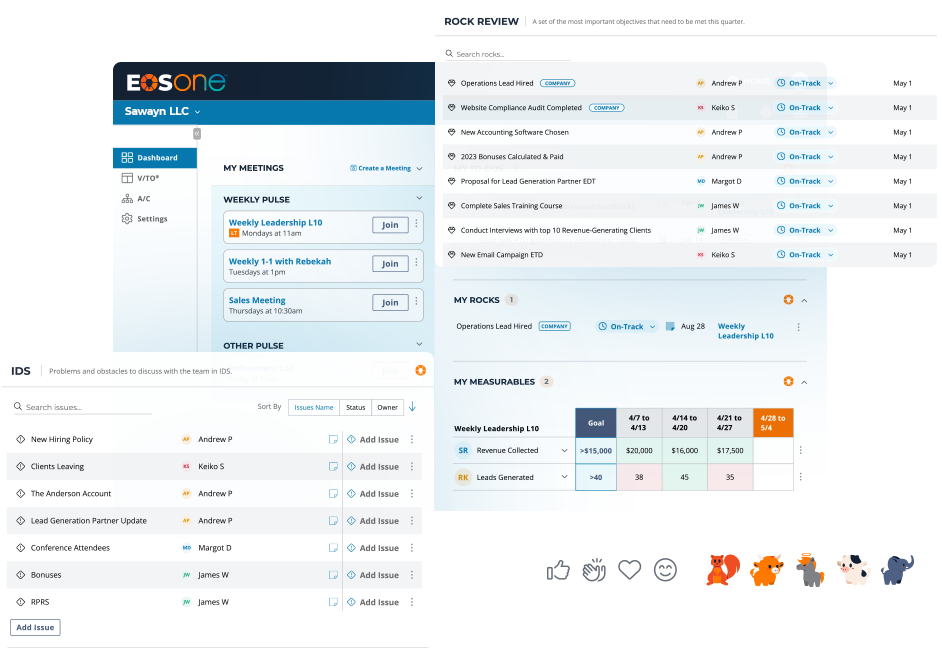To become your best as a leader and a manager, you need to create an environment of open and honest communication. While this is mostly facilitated in your Level 10 meetings, it is important to have regular 1 on 1 conversations with your team members.
In EOS we use a tool called ‘the 5-5-5’ or “Quarterly conversation” as a critical component of the 90 Day World in your organisation.
This is an informal conversation between you and your team member – it is not intended to replace a formal annual performance review, rather it is an opportunity for you to understand what is on each other’s minds, identify any issues and put a plan in place to solve them.
What does it cover
It’s called the 5-5-5 because it covers the 5 Core Values, the individuals 5 ROCKS and the 5 Roles of their seat on the Accountability Chart (now, we understand that you might not have exactly 5 core values, 5 rocks or 5 roles on their seat, but we call it the 555 to keep it simple)
There are 4 parts:
Part 1: What’s working / what’s not working
Part 2: IDS
Part 3: Feedback
Part 4: Next steps
Part 1 – What’s working / what’s not working
Ideally you and your employee have prepared for this, and have some points ready to share. .
- First your team member shares ‘what’s working’ (ask about what’s going well, what are the things they are happy about or proud of?)
- You then share ‘what’s working’ (Give feedback on how you see it, compliment them in the areas where they’re excelling)
- Then you both take turns to share ‘what’s not working’
What could be better? What could be frustrating them or what could be making their job more difficult? What would they change if they could? How could we improve? You are looking for issues.
Ideally they are doing most of the talking… as issues arise, you ask ‘should we drop that down to our issues list?’
After they are finished, you should also provide feedback and raise any issues that have not been addressed.
Part 2 – IDS
For this part you simply follow the Issues Solving Track from EOS using the IDS tool (Identify, Discuss, and Solve) – hopefully by now you and your team are well versed in this!)
Be mindful that you don’t take it upon yourself to solve all of the issues. Typically there will be three types of issues:
- Issues they must solve:
Don’t let your employee dump all their issues on you to solve. Act like a good parent – get them to talk through the issue and ask what some possible solutions could be – “what are some ways you can take the initiative on this issue”
- Issues you must solve:
There will always be some issues that the employee simply does not have the capacity or authority to solve (ie a broken process, an ill defined company ROCK, a people issue in another department). As the manager, it is your job to work towards a “solve” for these issues.
- Issues that can’t be solved:
There are some issues that just can’t be solved – ie market conditions, competitor actions, unrealistic pay demands. They just need a response, answer, or acknowledgment – you can say “I hear you, and I know it’s an issue that’s driving you crazy. What I need you to understand is that the issue that you are describing exists for the following reasons (state the reasons) and it’s not going to change. I just hope you can live with it even though I know you don’t agree with it.” (to quote Gino Wickman)
Part 3 – Feedback
This part provides an opportunity for the employee to give feedback on how you are doing as a manager. Is there anything you can be doing to support them, or help them to be more effective in their role? If you haven’t already done so, this is a great opportunity to get their perspective on whether you can answer ‘Yes’ to the 5 Leadership disciplines and 5 Management disciplines from the EOS tool LMA.
Part 4 – Next Steps
In this part you review any to-do’s that have been set – yours and theirs, and you should set the date and create the calendar invite for your next quarterly conversation. Finally, it always helps to offer some words of encouragement to help build their confidence for the quarter ahead.
Timing
The best time to hold your Quarterly conversation meetings is in the weeks leading up to your EOS Quarterly sessions (or Annual) with your leadership team. This way you will also be able to surface any relevant issues for the Leadership Team to IDS.
Over time you will find that these conversations serve as a very powerful way to create engagement and harness the energy of your entire organisation – keeping everyone in sync and focused on executing towards your vision.


